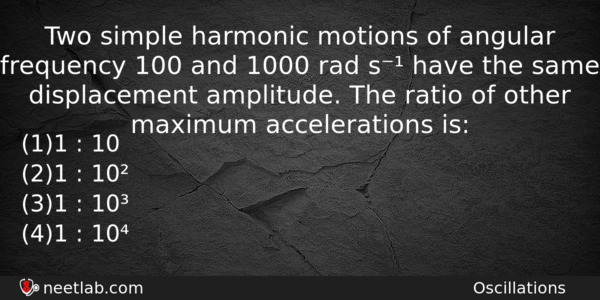| ⇦ | 
| ⇨ |
Two simple harmonic motions of angular frequency 100 and 1000 rad s⁻¹ have the same displacement amplitude. The ratio of other maximum accelerations is:
Options
(a) 1 : 10
(b) 1 : 10²
(c) 1 : 10³
(d) 1 : 10⁴
Correct Answer:
1 : 10²
Explanation:
Maximum acceleration of a particle in the simple harmonic motion is directly proportional to the square of angular frequency i.e., a(max)= – w ² A
As A remains same, we can say
a₁ / a₂ = w₁² / w₂² = (100)² / (1000)² = 1 / 100
⇒ a₁ : a₂ = 1 : 10²
Related Questions: - An electron in potentiometer experiences a force 2.4×10⁻¹⁹N. The length of potentiometer
- Two discs of moment of inertia l₁ and I₂ and angular speeds
- A coin of mass m and radius r having moment of inertia I about the axis passes
- A car is moving with uniform acceleration. It covers 200 m in 2 sec and 220 m
- An electron revolves in a circle at the rate of 10¹⁹ rounds per second.
Topics: Oscillations
(58)
Subject: Physics
(2479)
Important MCQs Based on Medical Entrance Examinations To Improve Your NEET Score
- An electron in potentiometer experiences a force 2.4×10⁻¹⁹N. The length of potentiometer
- Two discs of moment of inertia l₁ and I₂ and angular speeds
- A coin of mass m and radius r having moment of inertia I about the axis passes
- A car is moving with uniform acceleration. It covers 200 m in 2 sec and 220 m
- An electron revolves in a circle at the rate of 10¹⁹ rounds per second.
Topics: Oscillations (58)
Subject: Physics (2479)
Important MCQs Based on Medical Entrance Examinations To Improve Your NEET Score
18000+ students are using NEETLab to improve their score. What about you?
Solve Previous Year MCQs, Mock Tests, Topicwise Practice Tests, Identify Weak Topics, Formula Flash cards and much more is available in NEETLab Android App to improve your NEET score.
Share this page with your friends

Leave a Reply